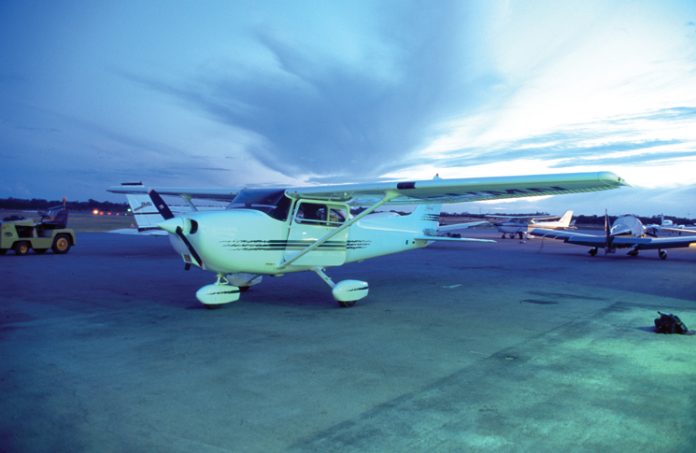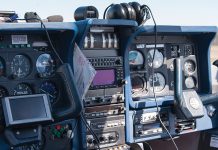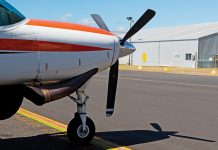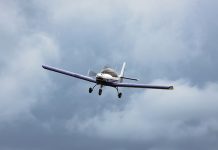1. Which personal documents need to be carried on a flight which is not recreational or aerobatic?
- flight crew licence
- flight crew medical certificate; or the equivalent for the recreational pilot; or a medical exemption
- a Commonwealth or State issued photographic ID issued within 10 years (e.g. your state driver licence); or ASIC
- all of the above
2. You are scheduled to conduct circuit training in a C172 with your instructor. A fellow student pilot would like to observe the training from the rear seat. Is this permitted by the pilot in command?
- yes
- no
- yes, provided they are considered to meet the definition of crew member
- no, they must be authorised by CASA
3. Smoking an electronic cigarette in cruise during a private flight is:
- illegal
- legal only when in the toilet
- legal at all times since the regulations do not apply to electronic cigarettes
- legal unless the pilot in command has switched on or displays a no smoking sign, or has directed a person not to smoke
4. Passenger briefings and safety instructions:
- only apply to Part 121 air transport flights
- do not apply to private flights
- do not apply to private flights unless the aircraft has an MTOW greater than 750 kg
- can be omitted for passengers who have been briefed when they have been carried previously in similar circumstances
5. A direction by the pilot in command to fasten seat belts:
- need only be given on Part 121 air transport flights
- need only be given when there is an imminent risk to safety
- need only be given before take-off and landing
- must be provided before taxiing
6. Which statements are false:
- a passenger must be prevented from boarding a flight if their blood alcohol exceeds .02 grams per 210 litres of breath or if they have consumed alcohol within 8 hours of the beginning of a flight
- a passenger must be prevented from boarding a flight if they are under the influence of psychoactive substances
- rules regarding psychoactive substances do not apply to passengers on private flights
- a passenger may consume alcohol if it is provided by the pilot in command
7. Carriage of an animal on a private flight:
- is not permitted except with CASA approval
- is permitted for assistance animals only
- is permitted with the permission of the pilot in command
- cannot be refused by the pilot in command or operator under the Disability Discrimination Act
8. You are conducting a private flight in a C172, can a passenger carry a firearm onboard?
- no
- yes, with CASA approval
- yes, with the permission of the pilot in command
- yes, providing the weapon is not discharged
9. When operating VFR in VMC above 1,000 ft AGL, your minimum horizontal separation from cloud is:
- 600 m in Class D
- 1500 m in Class D
- 1500 m in Class G and Class D
- not specified in Class G
10. For aircraft that are in the same vicinity, which is the correct right-of-way priority order?
- balloon, parachute, airship, unpowered glider, an aircraft towing another aircraft, power-driven aircraft
- balloon, parachute, unpowered glider, airship, an aircraft towing another aircraft, power-driven aircraft
- parachute, balloon, unpowered glider, airship, an aircraft towing another aircraft, power-driven aircraft
- an aircraft towing another aircraft, balloon, parachute, unpowered glider, airship, power-driven aircraft
11. You must declare ‘minimum fuel’ to ATC when you:
- will land with less than final reserve fuel
- are committed to land and any change to your ATC clearance means you may land with less than final reserve fuel
- may land with less than final reserve fuel
- are committed to land and any change to your ATC clearance means you will land with less than final reserve fuel
12. Which statement is more correct about refuelling an aircraft with an engine running (with other than highly volatile fuel)?
- you may only do so on aircraft which have an APU
- it may be done only with CASA approval
- it may be done on any aircraft provided the person refuelling cannot move into the arc of the propeller from the refuelling point
- only turbine-engine aircraft may be hot fuelled
13. If you are operating a C172 VFR in G airspace on a day private flight from Maree to Innamincka, flight notification is:
- required
- not required
- not required provided you do not proceed more than 120 nm from Maree
- not required provided you do not fly over water
14. In a single-engine aeroplane, the minimum ceiling and visibility for take-off are:
- for VFR flights, the VMC criteria for the class of airspace
- for IFR aircraft, cloud ceiling 300 ft, visibility 2,000 m
- for special VFR operations by day, clear of cloud with a visibility of 1,600 m
- all of the above
15. You are flying a C172 VFR but become distracted and find yourself over an extensive cloud layer unable to navigate by reference to the ground or water, what must you do?
- remain in VMC, declare an emergency and navigate using ground-based navigation aids
- remain in VMC and use dead reckoning to fix your position every 30 minutes, allowing for tracking errors of 9 degrees
- remain in VMC, declare an emergency and navigate using GNSS
- remain in VMC and navigate in accordance with the IFR navigation requirements set out in Part 91 MOS 14
Answers
- (d) [91.105; 91.100] [PEG 91 General Rules 1. Documentation p20]
- (c) [91.725, see definition of crew member] [PEG 91 General Rules 3. Training p26]
- (d) [91.530] [PEG 91 General Rules 5. Safety of Persons and Cargo p32]
- (d) [91.565] [PEG 91 General Rules 5. Safety of Persons and Cargo p35]
- (d) [91.570] [PEG 91 General Rules 5. Safety of Persons and Cargo p35]
- (a) (b) & (c) [91.780, 91.790, PEG 91 General Rules 5. Safety of Persons and Cargo]
- (c) [91.620] [PEG 91 General Rules 5. Safety of Persons and Cargo p38]
- (c) [91.160] [PEG 91 General Rules 5. Safety of Persons and Cargo p38]
- (a) [MOS 91 Table 2.07] [PEG 91 Operational Rules 6. Classification of Operation p42]
- (b) [91.330] [PEG 91 Operational Rules 7. Rules to prevent collision Table 9, p44]
- (d) [MOS 19.06] [PEG 91 Operational Rules 9. Fuel p64]
- (d) [91.495; 91.500] [MOS 19.06] [PEG 91 Operational Rules 9. Fuel p68]
- (a) [91.240] [remote area] [PEG 91 Operational Rules 10. Pre-flight planning and preparation p77]
- (d) [MOS 2.07] [15.06] [PEG 91 Operational Rules Classification of operation 6. P40, figure 3 p41, p43 and Operational Rules 13. IFR Take-off and landing p87]
- (d) [91.273] [MOS 13.02] [PEG 91 Operational Rules 15. Navigation pp 98, 99]





